Peer-Reviewed Publications by Haikel Lim
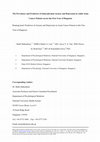
Aim: There is an increased prevalence of anxiety and depression in Asian patients diagnosed with ... more Aim: There is an increased prevalence of anxiety and depression in Asian patients diagnosed with cancers; these are known to interfere with treatment, treatment adherence, and mortality. The present study sought to investigate the prevalence and predictors of subsyndromal anxiety and depression in first year Asian cancer patients.
Methods: 206 patients newly-diagnosed with cancer in Singapore completed the Hospital Anxiety and Depression Scale (HADS) at T1 (baseline; on average 2 months post-diagnosis), T2 (3 months post-baseline), and T3 (6 months post-baseline). Subsyndromal anxiety and depression were identified using locally-validated cut-offs (HADS-A≥5 and HADS-D≥7). Adjusted odds ratios were calculated using baseline predictors.
Results: Across the three time points, 68–69% of participants were identified as having subsyndromal anxiety and close to 27–38% participants were identified as having subsyndromal depression. Multivariate logistic regressions revealed a lack of predictors for T1 subsyndromal anxiety and depression. Participants with late/metastatic stages of cancer were almost four times as likely to suffer from subsyndromal anxiety at T2. Single participants had a 75% lowered odds, but those living in 3–4 room public housing were close to four times as likely to suffer from, subsyndromal depression at T2. Older patients and those who had undergone surgery were found to significantly suffer from subsyndromal depression at T3.
Conclusion: The significant levels of depression and anxiety coupled with the lack of consistent predictors across the first year following cancer diagnosis further underscore the importance of careful assessment and clinician-vigilance in recognizing and identifying Asian patients who may express these emotional sequelæ following the cancer diagnosis. A better understanding of patients’ pathophysiological and psychological responses and individual strengths and coping skills are thus essential.
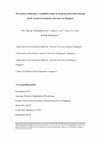
Objective. This study explores 1) the motivations and challenges facing family caregiving for can... more Objective. This study explores 1) the motivations and challenges facing family caregiving for cancer in Singapore and 2) suggests a possible framework to guide culturally-sensitive future work on caregivers. Design. 20 caregivers of patients being treated for cancer at a public hospital in Singapore were interviewed. A semi-structured interview format and inductive thematic analysis was used to analyse the data. Caregivers were asked about their motivations for caregiving and the challenges they faced. Results. Caregivers’ motivations grouped into three categories: personal value and fulfillment, giving care because of societal expectations such as filial piety, and practical need. Challenges were grouped into interpersonal challenges, disclosure and finding balance. Caregivers with different primary motivations varied in their responses to these challenges. More autonomous caregivers cited learning points and reprioritised more effectively than less autonomous caregivers, who reported more internal conflict and less control over their situation. Conclusions. In Singapore and Asia, socio-cultural values of family caregiving are not uniformly experienced as positive, and may be burdensome for caregivers who give care primarily for extrinsic motivations. As family caregiving needs increase, targeted psychosocial support for caregivers with less autonomous behavioural orientations may pre-empt caregiver burnout and burden
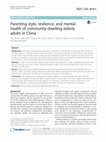
Background: Given the increasing elderly population worldwide, the identification of potential de... more Background: Given the increasing elderly population worldwide, the identification of potential determinants of successful ageing is important. Many studies have shown that parenting style and mental resilience may influence mental health; however, little is known about the psychological mechanisms that underpin this relationship. The current study sought to explore the relationships among mental resilience, perceptions of parents' parenting style, and depression and anxiety among community-dwelling elderly adults in China. Methods: In total, 439 community-dwelling elderly Chinese adults aged 60–91 years completed the Personal and Parents' Parenting Style Scale, Connor–Davidson Resilience Scale, Zung Self-Rating Depression Scale, and Zung Self-Rating Anxiety Scale. Results: Elderly adults whose parents preferred positive and authoritative parenting styles had higher levels of mental resilience and lower levels of depression and anxiety. Elderly adults parented in the authoritarian style were found to have higher levels of depression and anxiety, with lower mental resilience. Conclusions: The findings of this study provide evidence related to successful ageing and coping with life pressures, and highlight the important effects of parenting on mental health. The results suggest that examination of the proximal determinants of successful ageing is not sufficient—distal factors may also contribute to the 'success' of ageing by modifying key psychological dispositions that promote adaptation to adversity.
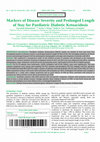
Introduction: Paediatric Diabetic Ketoacidosis (DKA) studies are limited in Asia and none have in... more Introduction: Paediatric Diabetic Ketoacidosis (DKA) studies are limited in Asia and none have investigated markers of disease severity or prolonged hospital Length Of Stay (LOS). We investigate predictors of disease severity and prolonged hospital LOS by analysing the demographics and signs and symptoms of patients with DKA. Methods: We conducted a retrospective study of the medical records of patients who presented to the emergency department of a tertiary paediatric hospital in Singapore between 2012 and 2013 and were diagnosed with DKA, obtaining demographics, signs, symptoms, serum pH levels, precipitating causes, and hospital LOS for the 67 eligible patients. Results: 82.1% of patients were tachycardic, 44.8% tachypneic and 20.9% febrile; none were hypotensive. The most common symptoms were nausea and vomiting (56.7%), polyuria and polydipsia (50.7%), lethargy (34.3%), and fever (22.4%).Half had mild DKA (48.5%) while a quarter of patients each had moderate (24.2%) and severe DKA (27.3%). A higher proportion of those with severe DKA presented with tachypnea (p=.007). Prolonged LOS patients were younger at presentation (p = .010), and a higher proportion had no prior history of DM (p=.061), presented with polyuria or polydipsia (p=.062) and had a lower pH on presentation (p=.056). Conclusions: Paediatric patients with DKA present with non-specific symptoms. Patients with tachypnea were more likely to have a worse disease severity. Younger patients, those without a history of DM, or had lower serum pH, and polyuria and polydipsia were more likely to have a prolonged hospital LOS.
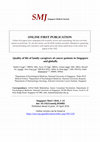
Introduction: Family caregivers of cancer patients often suffer from an impaired quality of life ... more Introduction: Family caregivers of cancer patients often suffer from an impaired quality of life (QOL) due to stress arising from the responsibility of caregiving. Most research on such QOL impairments were conducted in Western populations. Thus, this exploratory study sought to (a) examine the QOL levels of the family caregivers of cancer patients in an Asian population in Singapore, in relation to those of caregivers from other countries within and outside of Asia; and (b) investigate the association between sociodemographic factors and QOL impairments in family caregivers in Singapore.
Methods: A total of 258 family caregivers of cancer patients who were receiving outpatient treatment completed the Caregiver Quality of Life Index–Cancer (CQOLC) and a sociodemographic survey. Published CQOLC total scores from Turkey, Iran, Taiwan, Korea, the United Kingdom, the United States and Canada were used for comparison with the Singapore dataset, and demographic relationships were examined.
Results: Caregivers in Singapore and Asia have lower CQOLC total scores than their Western counterparts. Caregivers who were male, those of Chinese ethnicity, those who had parental relationships with their care recipient, and those caring for advanced-stage cancer patients were found to have an impaired QOL.
Conclusion: The findings of this study highlight possible areas in which support can be provided for family caregivers of cancer patients; there is a need to reconcile cultural diversity, values, societal expectations and demographic characteristics in Singapore.
Running head: PSYCHOLOGICAL RESOURCES IN ASIAN PERSONS WITH CANCER 2

Salvia divinorum, a sage plant with leaves that can produce a psychoactive high, has been used fo... more Salvia divinorum, a sage plant with leaves that can produce a psychoactive high, has been used for hundreds of years for its psycho-mimetic effects in religious rituals in South America. Salvia has now become popular mainly with adolescents and young adults for the short-lived relatively pleasant experiences many consider a “legal high” and its ready availability through Internet purchases. The main (psycho)active compound in salvia is Salvinorin A, a potent κ-opioid agonist and although the short and long- term effects have not been examined in sufficient detail, it is widely believed to have low addictive potential and low toxicity. Recent findings, however, seem to suggest that Salvinorin A can precipitate psychiatric symptoms and negatively affect cognition. Its ready availability and increasingly widespread use requires clinicians to have knowledge and awareness of its effects.
For the majority of patients with end-stage renal disease, dialysis is a lifelong treatment commo... more For the majority of patients with end-stage renal disease, dialysis is a lifelong treatment commonly associated with increased impairments in their quality of life (QOL) . Home-based modalities like peritoneal dialysis (PD) are thought to offer enhanced opportunities for autonomy, rehabilitation, and return to work, with flexibility in dialysis schedules in addition to costs savings and good clinical outcomes . Attention has therefore been directed to increase the uptake of PD, which, in most settings, still remains underutilized relative to hemodialysis (HD) .
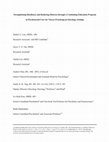
Resilience has been identified as key to protecting nurses against the sequelae of their work and... more Resilience has been identified as key to protecting nurses against the sequelae of their work and compassion fatigue; however, a recent review highlighted a lack of training programs targeted at improving resilience and studies providing evidence that resilience can even be strengthened in nurses. The present exploratory study sought to examine if a continuing education program for nurses practicing in oncology settings targeted at improving their knowledge, attitudes, and practice behaviours in psychosocial care would also have a secondary effect of improving resilience and reducing distress in these nurses. Non-parametric correlation analyses revealed that improvements in knowledge and self-reported practices were related to improvements in resilience, and that improvements in resilience were associated with reductions in distress. While more targeted research is required, findings provide preliminary evidence that continuing education programs targeted at psychosocial care may also be helpful in improving resilience in nurses and consequently reducing distress.
Caring for the caregiver while caring for the patient: Exploring the dyadic relationship between ... more Caring for the caregiver while caring for the patient: Exploring the dyadic relationship between patient spirituality and caregiver quality of life

Background: Given the high prevalence of cancer patients with comorbid depression, the present st... more Background: Given the high prevalence of cancer patients with comorbid depression, the present study sought to elucidate the relationships between two vulnerability factors, dysfunctional attitudes and rumination, and their influence on non-somatic depressive symptomatology in an Asian cohort of cancer patients. It was hypothesised that all variables of interest would be inter-correlated, and that both dysfunctional attitudes and rumination would mediate one another in influencing non-somatic depressive symptoms.
Methods: 194 recently diagnosed mixed-cancer patients in Singapore (Mage = 49.2 ± 9.2 years; 68% women; 61% ethnically Chinese), without any comorbid psychiatric diagnosis, completed the Dysfunctional Attitudes Scale Form A, Rumination Responses Scale (comprising brooding and reflective rumination), and Hospital Anxiety and Depression Scale.
Results: Correlational analyses revealed that all variables were inter-correlated (rhos[194] = .35–.52). Bootstrapping mediation analyses controlling for gender and treatment received revealed that both brooding and reflective rumination mediated the relationship between dysfunctional attitudes and non-somatic depressive symptoms, and that dysfunctional attitudes also mediated the relationship between both brooding and reflective rumination and non-somatic depressive symptoms.
Conclusions: Findings suggest that, in cancer patients, both dysfunctional attitudes and rumination seem to act upon one other, in a feedback loop, to influence non-somatic depressive symptomatology. Clinicians may therefore have a wider range of treatments to choose from in managing cancer patients with depressive symptomatology.
. Do caregivers of cancer patients receiving care in home hospice services have better quality of... more . Do caregivers of cancer patients receiving care in home hospice services have better quality of life? An exploratory investigation in Singapore.

Purpose: Cancer patients experience distress and high levels of psychosocial concerns. However, i... more Purpose: Cancer patients experience distress and high levels of psychosocial concerns. However, in Asian countries like Singapore, patients are often unwilling to seek support and help from mental healthcare professionals, but, instead, are more willing to confide in nurses. This quasi-experimental study developed and tested the efficacy of a brief nurse-led psychosocial intervention to alleviate these patients’ distress, minor psychiatric morbidity, and psychosocial concerns.
Methods: The semi-structured intervention comprised 20 to 30 minute face-to-face sessions with trained oncology nurses, monthly for 2 months, then bimonthly for 4 months. Patients received psycho-education on symptoms of stress, anxiety, and depression, and counseling, and were taught behavioral techniques such as deep breathing, progressive muscle relaxation, and positive self-talk.
Results: The results of this study found that patients who received the intervention had reduced distress, depression, and anxiety levels, and improved QOL at 6 months.
Conclusions: Although further research is necessary to explore the efficacy and viability of this intervention, findings support brief nurse-led psycho-educational interventions in Asian settings especially for cancer patients reluctant to seek help from mental health professionals.
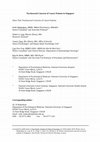
Asia-Pacific Journal of Clinical Oncology, 2015
Aims: Psychosocial needs are high amongst cancer patients, and screening for these is recognised ... more Aims: Psychosocial needs are high amongst cancer patients, and screening for these is recognised as integral to quality cancer care. This study identified the psychosocial needs of cancer patients at their first visit at a haematology-oncology clinic.
Methods: Fifty-four new consecutive patients completed the Distress Thermometer and the Problem List, the Hospital Anxiety and Depression Scale, and the EuroQol Quality of Life Scale at their first visit to plan for chemotherapy. Data was analysed with SPSS.
Results: Analyses revealed that participants had an average of 2.72 ± 2.29 problems, with 82% having psychosocial needs. Emotional concerns formed the top four psychosocial needs of the cohort (worry 46%, fears 26%, nervousness 26% and sadness 24%), with the fifth being a Practical concern (insurance/finance 22%). The former were more frequent amongst 41 to 50 year olds and significantly correlated with distress scores. Practical concerns were significantly correlated with depressive symptoms. Family concerns were more significant in women. The overall score on the Problem List correlated with distress, anxious symptomatology, and poorer quality of life scores.
Conclusions: Distress and psychosocial needs are high in cancer patients even at an early stage prior to chemotherapy. Attention to these needs is crucial as they cause significant distress and affect the patient’s quality of life.
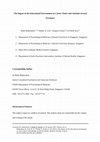
Medical Teacher, 2015
Background: The educational environment may influence students’ attitudes towards medical special... more Background: The educational environment may influence students’ attitudes towards medical specialties, which in turn can affect specialty career choices. The present study sought to establish if perceptions of the educational environment in a psychiatry rotation influenced attitudinal changes towards psychiatry in medical students and impacts decisions about psychiatry as a career choice.
Methods: The modified Attitudes to Psychiatry Scale, Dundee Ready Educational Environment Measure, and questions specific to career choice in psychiatry were administered to 100 undergraduates in a psychiatry rotation.
Results: Significant improvements in attitudes toward psychiatry were highly correlated with the educational environment, particularly when it was perceived as providing inspiration and enabling students to recognize the merits of psychiatry and the effectiveness of treatment. However, there was a worsening trend in the stigma to psychiatry in the posting, and only the positive attitudinal change (but not educational environment) influenced a career choice in psychiatry.
Conclusions: While the educational environment contributes towards positive attitudinal changes in a specialty rotation, stigma of psychiatry continues to be a limiting factor that is unfortunately not clearly addressed in the curriculum. The findings support the urgent need for interventions in this area.
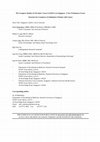
Purpose: The Caregiver Quality of Life Index – Cancer (CQOLC) is used worldwide to determine leve... more Purpose: The Caregiver Quality of Life Index – Cancer (CQOLC) is used worldwide to determine levels of quality of life (QOL) of caregivers of patients with cancer; however, the few studies examining the underlying factor structure of the CQOLC have revealed differences between Western and Eastern cultures. This study sought to confirm the differences in the factor structures between the original CQOLC and a Taiwanese version.
Methods: 183 caregivers from a cancer center in Singapore participated in this exploratory cross-sectional study. All participants completed the CQOLC and a sociodemographic form; 30 participants repeated the CQOLC two weeks later.
Results: Test-retest reliability was adequate for the CQOLC; however, confirmatory factor analyses did not support either the original four-factor model or the Taiwanese five-factor model. Exploratory factor analyses suggested the retaining of five factors to form a 25-item Singapore version (CQOLC-S25): Burden, Physical/Practical Concerns, Emotional Reactivity, Self-needs, and Social Support. Inter-factor and factor-scale correlations were positively significant for all factors except Support, which was negatively correlated with Emotional Reactivity and Self-needs.
Conclusions: Cross-cultural differences, which require further investigations, appear to underlie the utility and understanding of the CQOLC. More research is needed to better understand the needs of Singapore caregivers.
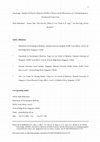
Purpose: Psychosocial distress in oncology patients may significantly interfere with their health... more Purpose: Psychosocial distress in oncology patients may significantly interfere with their health outcomes and quality of life. Nurses work closely with their patients and are in the best position to screen for distress and provide timely intervention. It is thus important for nurses working in oncology settings to be equipped and prepared to
address distressing psychosocial issues. The present study aims to investigate impact of a training program in psychosocial care on nurses' knowledge, attitudes, and clinical practice behaviors.
Methods: 180 nurses working in medical oncology and radiation oncology departments at the National University Cancer Institute Singapore underwent a training program in psychosocial care as part of their continuing nursing education curriculum. 154 of these nurses completed a self-designed questionnaire on nurses' Knowledge, Attitudes and Practice Behaviors (KAPb) at all four time points: baseline, post-training, and at six and 12 weeks post-training.
Results: The self-designed KAPb questionnaire proved adequate for this study. Positive gains on Applied Knowledge and Practice Behaviors were sustained over a 12-week period. There were no changes in Theoretical Knowledge. A decreasing trend in Attitudes was noted, although this was specific to the participants' attitudes toward the importance of emotional concerns as compared to physical concerns in cancer treatment. Enrolled nurses seemed to have higher starting levels of Theoretical Knowledge than did their registered counterparts. There were no other differences on demographic variables in relation to the efficacy of the training program.
Conclusions: The training program was successful in improving the applied knowledge and practice behaviors of nurses in providing psychosocial care for cancer patients. However, further refinement to the program, with particular attention to nurses' existing training and years of clinical nursing experience, would enhance staff empowerment and care improvement.
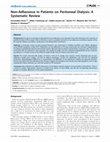
Background It has been increasingly recognized that non-adherence is an important factor that det... more Background It has been increasingly recognized that non-adherence is an important factor that determines the outcome of peritoneal dialysis (PD) therapy. There is therefore a need to establish the levels of non-adherence to different aspects of the PD regimen (dialysis procedures, medications, and dietary/fluid restrictions). Methods A systematic review of peer-reviewed literature was performed in PubMed, PsycINFO and CINAHL databases using PRISMA guidelines in May 2013. Publications on non-adherence in PD were selected by two reviewers independently according to predefined inclusion and exclusion criteria. Relevant data on patient characteristics, measures, rates and factors associated with non-adherence were extracted. The quality of studies was also evaluated independently by two reviewers according to a revised version of the Effective Public Health Practice Project assessment tool. Results The search retrieved 204 studies, of which a total of 25 studies met inclusion criteria. Reported rates of non-adherence varied across studies: 2.6–53% for dialysis exchanges, 3.9–85% for medication, and 14.4–67% for diet/fluid restrictions. Methodological differences in measurement and definition of non-adherence underlie the observed variation. Factors associated with non-adherence that showed a degree of consistency were mostly socio-demographical, such as age, employment status, ethnicity, sex, and time period on PD treatment. Conclusion Non-adherence to different dimensions of the dialysis regimen appears to be prevalent in PD patients. There is a need for further, high-quality research to explore these factors in more detail, with the aim of informing intervention designs to facilitate adherence in this patient population.
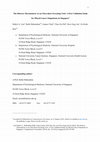
""Introduction: Research has shown that single-item tools, like the Distress Thermometer (DT), ar... more ""Introduction: Research has shown that single-item tools, like the Distress Thermometer (DT), are comparable to longer ones, like the Hospital Anxiety and Depression Scale (HADS). In this study, we tested the validity of the DT in a population of Singapore cancer outpatients, and determined the cutoff scores on the DT for clinically relevant distress and impaired quality of life (QOL). We also documented the prevalence of anxiety, depression, and QOL impairments in this population.
Methods: One hundred and five patients (Mdn age = 51-60 years, 64% female, and 71% Chinese) diagnosed with various cancers participated in this study. They completed a standard sociodemographic form, the DT and the Problem List, the HADS, and the EuroQOL Quality of Life Scale (EQ-5D).
Results: Almost a third of patients had clinically significant emotional distress, with 15-16% having probable levels of anxiety and depression. Almost half (41-55%) had an impaired QOL compared to Singapore population norms. Receiver operating characteristic curve analyses identified an area under the curve of 0.89 (SE = 0.36, 95% CI [0.82, 0.96], p < .001) when compared to the HADS cut-off score of 15. A cut-off score of 5 on the DT had the best sensitivity (0.88) and specificity (0.81). Participants above the DT cut-off score of 5 reported significantly more emotional problems (worry, nervousness, depression, sadness), insurance/finance-related problems, and sleep problems. They also scoredsignificantly lower on EQ-5D, with more QOL impairments in the domains of carrying out their usual
activities and anxiety/depression.
Conclusion: Levels of distress, anxiety, depression, and QOL impairments are high in this population. The DT was found to be a valid tool for distress screening in the Singapore cancer population, with a recommended cut-off score of 5.""







Uploads
Peer-Reviewed Publications by Haikel Lim
Methods: 206 patients newly-diagnosed with cancer in Singapore completed the Hospital Anxiety and Depression Scale (HADS) at T1 (baseline; on average 2 months post-diagnosis), T2 (3 months post-baseline), and T3 (6 months post-baseline). Subsyndromal anxiety and depression were identified using locally-validated cut-offs (HADS-A≥5 and HADS-D≥7). Adjusted odds ratios were calculated using baseline predictors.
Results: Across the three time points, 68–69% of participants were identified as having subsyndromal anxiety and close to 27–38% participants were identified as having subsyndromal depression. Multivariate logistic regressions revealed a lack of predictors for T1 subsyndromal anxiety and depression. Participants with late/metastatic stages of cancer were almost four times as likely to suffer from subsyndromal anxiety at T2. Single participants had a 75% lowered odds, but those living in 3–4 room public housing were close to four times as likely to suffer from, subsyndromal depression at T2. Older patients and those who had undergone surgery were found to significantly suffer from subsyndromal depression at T3.
Conclusion: The significant levels of depression and anxiety coupled with the lack of consistent predictors across the first year following cancer diagnosis further underscore the importance of careful assessment and clinician-vigilance in recognizing and identifying Asian patients who may express these emotional sequelæ following the cancer diagnosis. A better understanding of patients’ pathophysiological and psychological responses and individual strengths and coping skills are thus essential.
Methods: A total of 258 family caregivers of cancer patients who were receiving outpatient treatment completed the Caregiver Quality of Life Index–Cancer (CQOLC) and a sociodemographic survey. Published CQOLC total scores from Turkey, Iran, Taiwan, Korea, the United Kingdom, the United States and Canada were used for comparison with the Singapore dataset, and demographic relationships were examined.
Results: Caregivers in Singapore and Asia have lower CQOLC total scores than their Western counterparts. Caregivers who were male, those of Chinese ethnicity, those who had parental relationships with their care recipient, and those caring for advanced-stage cancer patients were found to have an impaired QOL.
Conclusion: The findings of this study highlight possible areas in which support can be provided for family caregivers of cancer patients; there is a need to reconcile cultural diversity, values, societal expectations and demographic characteristics in Singapore.
Methods: 194 recently diagnosed mixed-cancer patients in Singapore (Mage = 49.2 ± 9.2 years; 68% women; 61% ethnically Chinese), without any comorbid psychiatric diagnosis, completed the Dysfunctional Attitudes Scale Form A, Rumination Responses Scale (comprising brooding and reflective rumination), and Hospital Anxiety and Depression Scale.
Results: Correlational analyses revealed that all variables were inter-correlated (rhos[194] = .35–.52). Bootstrapping mediation analyses controlling for gender and treatment received revealed that both brooding and reflective rumination mediated the relationship between dysfunctional attitudes and non-somatic depressive symptoms, and that dysfunctional attitudes also mediated the relationship between both brooding and reflective rumination and non-somatic depressive symptoms.
Conclusions: Findings suggest that, in cancer patients, both dysfunctional attitudes and rumination seem to act upon one other, in a feedback loop, to influence non-somatic depressive symptomatology. Clinicians may therefore have a wider range of treatments to choose from in managing cancer patients with depressive symptomatology.
Methods: The semi-structured intervention comprised 20 to 30 minute face-to-face sessions with trained oncology nurses, monthly for 2 months, then bimonthly for 4 months. Patients received psycho-education on symptoms of stress, anxiety, and depression, and counseling, and were taught behavioral techniques such as deep breathing, progressive muscle relaxation, and positive self-talk.
Results: The results of this study found that patients who received the intervention had reduced distress, depression, and anxiety levels, and improved QOL at 6 months.
Conclusions: Although further research is necessary to explore the efficacy and viability of this intervention, findings support brief nurse-led psycho-educational interventions in Asian settings especially for cancer patients reluctant to seek help from mental health professionals.
Methods: Fifty-four new consecutive patients completed the Distress Thermometer and the Problem List, the Hospital Anxiety and Depression Scale, and the EuroQol Quality of Life Scale at their first visit to plan for chemotherapy. Data was analysed with SPSS.
Results: Analyses revealed that participants had an average of 2.72 ± 2.29 problems, with 82% having psychosocial needs. Emotional concerns formed the top four psychosocial needs of the cohort (worry 46%, fears 26%, nervousness 26% and sadness 24%), with the fifth being a Practical concern (insurance/finance 22%). The former were more frequent amongst 41 to 50 year olds and significantly correlated with distress scores. Practical concerns were significantly correlated with depressive symptoms. Family concerns were more significant in women. The overall score on the Problem List correlated with distress, anxious symptomatology, and poorer quality of life scores.
Conclusions: Distress and psychosocial needs are high in cancer patients even at an early stage prior to chemotherapy. Attention to these needs is crucial as they cause significant distress and affect the patient’s quality of life.
Methods: The modified Attitudes to Psychiatry Scale, Dundee Ready Educational Environment Measure, and questions specific to career choice in psychiatry were administered to 100 undergraduates in a psychiatry rotation.
Results: Significant improvements in attitudes toward psychiatry were highly correlated with the educational environment, particularly when it was perceived as providing inspiration and enabling students to recognize the merits of psychiatry and the effectiveness of treatment. However, there was a worsening trend in the stigma to psychiatry in the posting, and only the positive attitudinal change (but not educational environment) influenced a career choice in psychiatry.
Conclusions: While the educational environment contributes towards positive attitudinal changes in a specialty rotation, stigma of psychiatry continues to be a limiting factor that is unfortunately not clearly addressed in the curriculum. The findings support the urgent need for interventions in this area.
Methods: 183 caregivers from a cancer center in Singapore participated in this exploratory cross-sectional study. All participants completed the CQOLC and a sociodemographic form; 30 participants repeated the CQOLC two weeks later.
Results: Test-retest reliability was adequate for the CQOLC; however, confirmatory factor analyses did not support either the original four-factor model or the Taiwanese five-factor model. Exploratory factor analyses suggested the retaining of five factors to form a 25-item Singapore version (CQOLC-S25): Burden, Physical/Practical Concerns, Emotional Reactivity, Self-needs, and Social Support. Inter-factor and factor-scale correlations were positively significant for all factors except Support, which was negatively correlated with Emotional Reactivity and Self-needs.
Conclusions: Cross-cultural differences, which require further investigations, appear to underlie the utility and understanding of the CQOLC. More research is needed to better understand the needs of Singapore caregivers.
address distressing psychosocial issues. The present study aims to investigate impact of a training program in psychosocial care on nurses' knowledge, attitudes, and clinical practice behaviors.
Methods: 180 nurses working in medical oncology and radiation oncology departments at the National University Cancer Institute Singapore underwent a training program in psychosocial care as part of their continuing nursing education curriculum. 154 of these nurses completed a self-designed questionnaire on nurses' Knowledge, Attitudes and Practice Behaviors (KAPb) at all four time points: baseline, post-training, and at six and 12 weeks post-training.
Results: The self-designed KAPb questionnaire proved adequate for this study. Positive gains on Applied Knowledge and Practice Behaviors were sustained over a 12-week period. There were no changes in Theoretical Knowledge. A decreasing trend in Attitudes was noted, although this was specific to the participants' attitudes toward the importance of emotional concerns as compared to physical concerns in cancer treatment. Enrolled nurses seemed to have higher starting levels of Theoretical Knowledge than did their registered counterparts. There were no other differences on demographic variables in relation to the efficacy of the training program.
Conclusions: The training program was successful in improving the applied knowledge and practice behaviors of nurses in providing psychosocial care for cancer patients. However, further refinement to the program, with particular attention to nurses' existing training and years of clinical nursing experience, would enhance staff empowerment and care improvement.
Methods: One hundred and five patients (Mdn age = 51-60 years, 64% female, and 71% Chinese) diagnosed with various cancers participated in this study. They completed a standard sociodemographic form, the DT and the Problem List, the HADS, and the EuroQOL Quality of Life Scale (EQ-5D).
Results: Almost a third of patients had clinically significant emotional distress, with 15-16% having probable levels of anxiety and depression. Almost half (41-55%) had an impaired QOL compared to Singapore population norms. Receiver operating characteristic curve analyses identified an area under the curve of 0.89 (SE = 0.36, 95% CI [0.82, 0.96], p < .001) when compared to the HADS cut-off score of 15. A cut-off score of 5 on the DT had the best sensitivity (0.88) and specificity (0.81). Participants above the DT cut-off score of 5 reported significantly more emotional problems (worry, nervousness, depression, sadness), insurance/finance-related problems, and sleep problems. They also scoredsignificantly lower on EQ-5D, with more QOL impairments in the domains of carrying out their usual
activities and anxiety/depression.
Conclusion: Levels of distress, anxiety, depression, and QOL impairments are high in this population. The DT was found to be a valid tool for distress screening in the Singapore cancer population, with a recommended cut-off score of 5.""
Methods: 206 patients newly-diagnosed with cancer in Singapore completed the Hospital Anxiety and Depression Scale (HADS) at T1 (baseline; on average 2 months post-diagnosis), T2 (3 months post-baseline), and T3 (6 months post-baseline). Subsyndromal anxiety and depression were identified using locally-validated cut-offs (HADS-A≥5 and HADS-D≥7). Adjusted odds ratios were calculated using baseline predictors.
Results: Across the three time points, 68–69% of participants were identified as having subsyndromal anxiety and close to 27–38% participants were identified as having subsyndromal depression. Multivariate logistic regressions revealed a lack of predictors for T1 subsyndromal anxiety and depression. Participants with late/metastatic stages of cancer were almost four times as likely to suffer from subsyndromal anxiety at T2. Single participants had a 75% lowered odds, but those living in 3–4 room public housing were close to four times as likely to suffer from, subsyndromal depression at T2. Older patients and those who had undergone surgery were found to significantly suffer from subsyndromal depression at T3.
Conclusion: The significant levels of depression and anxiety coupled with the lack of consistent predictors across the first year following cancer diagnosis further underscore the importance of careful assessment and clinician-vigilance in recognizing and identifying Asian patients who may express these emotional sequelæ following the cancer diagnosis. A better understanding of patients’ pathophysiological and psychological responses and individual strengths and coping skills are thus essential.
Methods: A total of 258 family caregivers of cancer patients who were receiving outpatient treatment completed the Caregiver Quality of Life Index–Cancer (CQOLC) and a sociodemographic survey. Published CQOLC total scores from Turkey, Iran, Taiwan, Korea, the United Kingdom, the United States and Canada were used for comparison with the Singapore dataset, and demographic relationships were examined.
Results: Caregivers in Singapore and Asia have lower CQOLC total scores than their Western counterparts. Caregivers who were male, those of Chinese ethnicity, those who had parental relationships with their care recipient, and those caring for advanced-stage cancer patients were found to have an impaired QOL.
Conclusion: The findings of this study highlight possible areas in which support can be provided for family caregivers of cancer patients; there is a need to reconcile cultural diversity, values, societal expectations and demographic characteristics in Singapore.
Methods: 194 recently diagnosed mixed-cancer patients in Singapore (Mage = 49.2 ± 9.2 years; 68% women; 61% ethnically Chinese), without any comorbid psychiatric diagnosis, completed the Dysfunctional Attitudes Scale Form A, Rumination Responses Scale (comprising brooding and reflective rumination), and Hospital Anxiety and Depression Scale.
Results: Correlational analyses revealed that all variables were inter-correlated (rhos[194] = .35–.52). Bootstrapping mediation analyses controlling for gender and treatment received revealed that both brooding and reflective rumination mediated the relationship between dysfunctional attitudes and non-somatic depressive symptoms, and that dysfunctional attitudes also mediated the relationship between both brooding and reflective rumination and non-somatic depressive symptoms.
Conclusions: Findings suggest that, in cancer patients, both dysfunctional attitudes and rumination seem to act upon one other, in a feedback loop, to influence non-somatic depressive symptomatology. Clinicians may therefore have a wider range of treatments to choose from in managing cancer patients with depressive symptomatology.
Methods: The semi-structured intervention comprised 20 to 30 minute face-to-face sessions with trained oncology nurses, monthly for 2 months, then bimonthly for 4 months. Patients received psycho-education on symptoms of stress, anxiety, and depression, and counseling, and were taught behavioral techniques such as deep breathing, progressive muscle relaxation, and positive self-talk.
Results: The results of this study found that patients who received the intervention had reduced distress, depression, and anxiety levels, and improved QOL at 6 months.
Conclusions: Although further research is necessary to explore the efficacy and viability of this intervention, findings support brief nurse-led psycho-educational interventions in Asian settings especially for cancer patients reluctant to seek help from mental health professionals.
Methods: Fifty-four new consecutive patients completed the Distress Thermometer and the Problem List, the Hospital Anxiety and Depression Scale, and the EuroQol Quality of Life Scale at their first visit to plan for chemotherapy. Data was analysed with SPSS.
Results: Analyses revealed that participants had an average of 2.72 ± 2.29 problems, with 82% having psychosocial needs. Emotional concerns formed the top four psychosocial needs of the cohort (worry 46%, fears 26%, nervousness 26% and sadness 24%), with the fifth being a Practical concern (insurance/finance 22%). The former were more frequent amongst 41 to 50 year olds and significantly correlated with distress scores. Practical concerns were significantly correlated with depressive symptoms. Family concerns were more significant in women. The overall score on the Problem List correlated with distress, anxious symptomatology, and poorer quality of life scores.
Conclusions: Distress and psychosocial needs are high in cancer patients even at an early stage prior to chemotherapy. Attention to these needs is crucial as they cause significant distress and affect the patient’s quality of life.
Methods: The modified Attitudes to Psychiatry Scale, Dundee Ready Educational Environment Measure, and questions specific to career choice in psychiatry were administered to 100 undergraduates in a psychiatry rotation.
Results: Significant improvements in attitudes toward psychiatry were highly correlated with the educational environment, particularly when it was perceived as providing inspiration and enabling students to recognize the merits of psychiatry and the effectiveness of treatment. However, there was a worsening trend in the stigma to psychiatry in the posting, and only the positive attitudinal change (but not educational environment) influenced a career choice in psychiatry.
Conclusions: While the educational environment contributes towards positive attitudinal changes in a specialty rotation, stigma of psychiatry continues to be a limiting factor that is unfortunately not clearly addressed in the curriculum. The findings support the urgent need for interventions in this area.
Methods: 183 caregivers from a cancer center in Singapore participated in this exploratory cross-sectional study. All participants completed the CQOLC and a sociodemographic form; 30 participants repeated the CQOLC two weeks later.
Results: Test-retest reliability was adequate for the CQOLC; however, confirmatory factor analyses did not support either the original four-factor model or the Taiwanese five-factor model. Exploratory factor analyses suggested the retaining of five factors to form a 25-item Singapore version (CQOLC-S25): Burden, Physical/Practical Concerns, Emotional Reactivity, Self-needs, and Social Support. Inter-factor and factor-scale correlations were positively significant for all factors except Support, which was negatively correlated with Emotional Reactivity and Self-needs.
Conclusions: Cross-cultural differences, which require further investigations, appear to underlie the utility and understanding of the CQOLC. More research is needed to better understand the needs of Singapore caregivers.
address distressing psychosocial issues. The present study aims to investigate impact of a training program in psychosocial care on nurses' knowledge, attitudes, and clinical practice behaviors.
Methods: 180 nurses working in medical oncology and radiation oncology departments at the National University Cancer Institute Singapore underwent a training program in psychosocial care as part of their continuing nursing education curriculum. 154 of these nurses completed a self-designed questionnaire on nurses' Knowledge, Attitudes and Practice Behaviors (KAPb) at all four time points: baseline, post-training, and at six and 12 weeks post-training.
Results: The self-designed KAPb questionnaire proved adequate for this study. Positive gains on Applied Knowledge and Practice Behaviors were sustained over a 12-week period. There were no changes in Theoretical Knowledge. A decreasing trend in Attitudes was noted, although this was specific to the participants' attitudes toward the importance of emotional concerns as compared to physical concerns in cancer treatment. Enrolled nurses seemed to have higher starting levels of Theoretical Knowledge than did their registered counterparts. There were no other differences on demographic variables in relation to the efficacy of the training program.
Conclusions: The training program was successful in improving the applied knowledge and practice behaviors of nurses in providing psychosocial care for cancer patients. However, further refinement to the program, with particular attention to nurses' existing training and years of clinical nursing experience, would enhance staff empowerment and care improvement.
Methods: One hundred and five patients (Mdn age = 51-60 years, 64% female, and 71% Chinese) diagnosed with various cancers participated in this study. They completed a standard sociodemographic form, the DT and the Problem List, the HADS, and the EuroQOL Quality of Life Scale (EQ-5D).
Results: Almost a third of patients had clinically significant emotional distress, with 15-16% having probable levels of anxiety and depression. Almost half (41-55%) had an impaired QOL compared to Singapore population norms. Receiver operating characteristic curve analyses identified an area under the curve of 0.89 (SE = 0.36, 95% CI [0.82, 0.96], p < .001) when compared to the HADS cut-off score of 15. A cut-off score of 5 on the DT had the best sensitivity (0.88) and specificity (0.81). Participants above the DT cut-off score of 5 reported significantly more emotional problems (worry, nervousness, depression, sadness), insurance/finance-related problems, and sleep problems. They also scoredsignificantly lower on EQ-5D, with more QOL impairments in the domains of carrying out their usual
activities and anxiety/depression.
Conclusion: Levels of distress, anxiety, depression, and QOL impairments are high in this population. The DT was found to be a valid tool for distress screening in the Singapore cancer population, with a recommended cut-off score of 5.""
increasingly dependent on lifelong dialysis as their only means of renal replacement therapy. However, despite the improvements in dialysis techniques/procedures and care, there are still high mortality rates, which are significantly predicted by a lowered quality of life (QoL). This chapter, therefore, addresses QoL issues in ESKD. We first explore the various issues surrounding QoL in dialysis research. We then briefly review the empirical findings and limitations in this area. We end by proposing applications of QoL research in clinical settings, and examine empirical research that might potentially assist patients with decision-making for different treatment modalities.
Psychiatric comorbidity is common in cancer patients, with the presentation of psychiatric symptoms such as depression, anxiety and distress. This comorbidity may be higher in elderly patients, who are more vulnerable to developing such symptoms. In order to provide adequate and appropriate psychosocial support for elderly cancer patients, there is a need to investigate the differential psychological impact that these patients face, in comparison to younger patients.
Objective:
In the context of a local healthcare setting, the aim of this study was to (1) investigate if elderly patients had higher levels of psychiatric symptoms (depression, anxiety and distress) than younger patients; (2) examine the changes in the levels of psychiatric symptoms over a period of time; (3) investigate changes in the number of caseness of psychiatric morbidities for each patient population over the same period of time.
Methods:
157 cancer patients from the National University Cancer Institute, Singapore, participated in this longitudinal study. 35% (n = 54) of the patients were aged 61 years and above (elderly). Self-report questionnaires measuring distress (Distress Thermometer), and depression and anxiety (Hospital Anxiety and Depression Scale) were administered at 3 time points (baseline, 2 months and 5 months). An independent samples t-test was used to compare the levels of distress, depression and anxiety for both groups at baseline. ANOVA was used to compare the measures both across time, as well as the elderly patients with the younger ones. Chi-square tests were used to analyse the prevalence of caseness in the two groups of patients.
Results:
Results indicated that for all symptoms at baseline, elderly patients did not report experiencing significantly higher levels compared to younger patients. For all patients, comparing baseline to 2 months, and baseline to 5 months, there was a significant decrease in the all symptoms, except for distress at 5 months which showed a marginally significant decrease. However, comparing between elderly and young patients over time, there was no significant difference in the levels of all symptoms. In addition, although marginally significant, the prevalence of caseness in the elderly patients was higher compared to the young patients, for depression at baseline (χ2[1,118] = 3.577, p = .059) and for distress at 2 months (χ2[1,73] = 3.273, p = .070). Apart from these two exceptions, there was no significant difference between elderly and young patients in the prevalence of caseness for all the symptoms at all three time points.
Conclusion:
This study has shown that elderly patients generally do not experience more symptoms of depression, anxiety or distress compared to younger patients. Instead, all patients exhibit a trajectory of decreasing symptoms over time. Attention should be paid however, to elderly caseness patients. Future research could investigate the profile of elderly caseness patients and the changes in symptom level over time, to allow for healthcare professionals to provide the appropriate psychosocial support for them.
Elderly individuals with cancer may face higher levels of emotional issues, which are associated with higher risks of psychiatric sequelae and an impaired quality of life (QOL). While much research has been done on Western populations, little is known about the prevalence of distress, depression, anxiety, and QOL in Asian countries, much less Singapore.
Objective:
Given the relatively sparse research in this area in Singapore, especially with a growing ageing population, this study sought to (1) investigate the relationship between age and distress, depression, anxiety, and QOL in cancer patients; (2) compare the levels of these variables between elderly and younger cancer patients and determine the prevalence of caseness for these psychiatric sequelae; and (3) examine if the elderly were at greater risk of developing caseness of these psychiatric morbidities as compared to younger patients.
Methods:
115 newly-diagnosed (within 2.19 ± 1.10 months) mixed-cancer patients (Mage = 49.59 ± 10.02 years; 68% female; 59% Chinese; 72% married; no psychiatric morbidity; 1.42 ± 0.68 medical co-morbidities) undergoing chemotherapy at the National University Cancer Institute, Singapore, participated in this on-going cohort study. Patients completed a basic sociodemographic form and measures of distress (Distress Thermometer; DT), depression and anxiety (Hospital Anxiety and Depression Scale; HADS-D and HADS-A, respectively), and QOL (EQ-5D-5L-VAS). 17% (n = 19) of the patients were above the age of 60 (elderly). Analyses involved Pearson’s correlations to determine associations between age and variables of interest, independent samples t tests to determine group differences, and chi-square analyses to determine probable risk of caseness. Caseness was determined by validated local cut-offs: DT ≥ 4; HADS-D ≥ 8; and HADS-A ≥ 6.
Results:
Age was not significantly correlated to any of the variables of interest; however, further analyses revealed that the elderly were found to have marginally significantly higher HADS-D scores (7.11 ± 4.05 vs. 5.14 ± 4.08; t[111] = −1.92, p = .057) and lower EQ-5D-5L-VAS (52.56 ± 23.48 vs. 63.65 ± 21.61; t[108] = 1.96, p = .052) than younger patients. The prevalence of caseness for psychiatric sequelae in the elderly of this population was 35% for distress, 47% for depression, and 53% for anxiety, with only depression being marginally significantly higher in the elderly (χ2[1,113] = 3.65, p = .056).
Conclusions:
Results of this study suggest that patients above the age of 60 appear to face significant QOL impairments, with a third facing significant levels of emotional distress, and half facing high levels of depression and anxiety. Depression seems to be a significant key concern in these elderly, which, elsewhere, has been shown to affect treatment adherence and outcomes. Recognizing this early, especially in the elderly, will result in greater attention to emotional needs assessments, and better care planning and service provision in Singapore, at least, and elsewhere in Asia.
Methods: Ninety-seven patients from the National University Cancer Institute, Singapore, completed the Distress Thermometer (DT), and Hospital Anxiety and Depression Scale (HADS). To distinguish between normal and borderline clinical cases of anxiety and depression for both subscales of the HADS (HADS-A and HADS-D, respectively), we used the suggested cut-off score of 7/8.
Results: Receiver operating characteristic (ROC) curve analyses identified an area under curve (AUC) of .87 (95% CI [.79, .95], p < .001) for DT on HADS-A. Similarly, the ROC curve of DT on HADS-D had an AUC of .85 (95% CI [.76, .94], p < .001). Our analyses further revealed that a cut-off score of 4/5 on the DT yielded the best sensitivity–specificity balance for both HADS-A (sensitivity = .79, specificity = .80) and HADS-D, (sensitivity = .83; specificity = .76). Thirty-seven percent (N = 37) of our population scored 5 or more on the DT.
Discussion & Conclusion: The DT showed optimal sensitivity (.79–.83) and specificity (.76–.80) in detecting borderline clinical cases of anxiety/depression in our population, comparable to that of the HADS. Its brevity and good performance leads us to suggest that the DT is a quick effective tool, over the HADS, for routine screenings in clinical oncology outpatient settings.
Methods: Fifty-nine patients from the National University Cancer Institute, Singapore, were assessed for distress using the Distress Thermometer (DT) at baseline (T1) and at one-month follow-up (T2). Patients were randomized into two groups: treatment with nurse-led skills training (n = 30) and treatment as usual (n = 29). Patients in the skills-training group were taught stress management and relaxation skills by nurses.
Results: We found a significant interaction between patients' distress and treatment group, F(1, 57) = 13.98, Mse = 2.51, p < .001. Patients in the skills-training group had significantly lowered mean DT scores at T2 (4.93 to 3.13), F(1, 29) = 17.10, Mse = 2.84, p < .001, d = .0.69. Although there were no significant differences in mean DT scores at T2 for patients undergoing treatment as usual, a slight increase was observed (2.00 to 2.38).
Discussion & Conclusion: Nurse-led skills training appears to be effective in reducing distress in cancer patients after one month. We suggest that it may be helpful to incorporate similar services into nurses’ routine practice as a preventive measure for potential psychiatric complications. Future studies with similar programs, based on randomized controlled trials, are needed to replicate results.
Individuals diagnosed with cancer are often highly distressed but less willing to commit to seeing psychiatrists, preferring, instead, informal nurse-interactions. In this study, we examined the efficacy of brief nurse-led psychosocial interventions for cancer patients.
METHODS:
This ethics-approved study was conducted as part of a Healthcare Quality Improvement Project in Singapore. 110 participants were offered the intervention; 51 (46%) were not keen in participating and formed the Control group. Baseline and 5 months measurements of distress (DT), anxiety and depression (HADS), and quality of life (EQ-5D) were taken. The 20-minute intervention was delivered face-to-face by trained nurses monthly for 3 months, then bimonthly for 6 months. It included psycho-education on distress symptom recognition and management, and both cognitive and behavioral relaxation techniques.
RESULTS:
Analyses revealed that there were significant reductions in DT and HADS (t[59] = 3.35–6.18, ps < .05), and significant improvements in EQ-5D scores (t[59] = 3.18, p < .05) in the intervention but not control group between baseline and 5 months.
CONCLUSIONS
These preliminary results suggest that nurse-led interventions may be sufficient in managing pre-clinical levels of distress, anxiety, and depression in patients with cancer but must be supported by appropriate nurse training and empowerment.
With psychiatry on the decline as a career choice, it is surprising that no published studies have examined the interplay of attitudes to psychiatry and the learning environment; this study addresses this lacuna.
METHODS:
This ethics-approved study was conducted on 100 medical students (National University of Singapore) undergoing their psychiatry rotation. Baseline and post-rotation assessments of their attitudes to psychiatry (mAPS) and learning environment (DREEM) were obtained.
RESULTS:
Analyses revealed that the clerkship significantly improved attitudinal scores (Z = −3.09, p = .002), and these were a result of the environment (rho[100] = .29, p = .003), specifically, their perception of learning, teachers, the atmosphere, and their social self-perceptions (rhos[100] = .21–.30, ps < .05), but not academic self-perceptions. Interestingly, the clerkship showed that the learning environment significantly influenced changes in all mAPS subscales (merits of psychiatry as scientific medicine, effectiveness of treatment, inspiration from medical school) except stigma of psychiatry (rho[100] = .18, p = .10).
CONCLUSIONS
These preliminary results suggest the importance of the learning environment during clerkship in improving future physicians’ attitudes toward psychiatry; however, more still needs to be done to address the stigma of this discipline.
Method: 179 healthy undergraduates from National University of Singapore (21.8 ± 1.6 years of age; 56% female; 88% ethnically Chinese) participated in this cross-sectional study. Participants filled out a pen-and-paper questionnaire comprising validated measures of (1) mindfulness, the Five-factor Mindfulness Questionnaire – Short Form (FFMQ-SF; Bohlmeijer et al., 2011); (2) rumination, the Ruminative Response Style Questionnaire, (RRS; Nolen-Hoeksema & Morrow, 1991); and (3) FHS, the vignette version of the General Help-seeking Questionnaire (GHSQ-V; Wilson et al., 2005).
Results: Inconsistent with our first hypothesis, a preliminary look presented no significant relationship between mindfulness and FHS; however, further analyses revealed that this was because only two of the FFMQ-SF subscales, observing and non-judging, were correlated to GHSQ-V, rs = −.02 and .17, respectively. While rumination was negatively correlated with FHS, we discovered that only the reflection subscale of the RRS was correlated with aspects of the FFMQ-SF and the GHSQ-V. Mediation analyses revealed a full significant positive mediation of reflection on the link between non-judging and FHS (Sobel’s z = 2.46, p = .01) but a partial significant negative mediation of reflection on the link between observing and FHS (Sobel’s z = -2.10, p = .03).
Discussion and Conclusions: The results of our study preliminarily suggest that there are differential roles of both rumination and mindfulness on FHS. Clinicians and practitioners alike should be wary of wholeheartedly embracing all aspects of mindfulness-based interventions: the non-judging aspect of mindfulness improves FHS, while the observing aspect seems to lower FHS. Further, reflective, and not brooding, rumination seems to be the conduit through which mindfulness influences FHS. As such, in the interest of improving FHS, there is a greater urgency in emphasizing reflective rumination in the context of being non-judgmental, but not in that of being observant.
Methods: 113 consecutive patients (65% female; 71% Chinese; Median age range: 51 to 60 years) completed the EuroQol QOL Scale (EQ-5D-VAS), Hospital Anxiety and Depression Scale (HADS), and Distress Thermometer (DT). Those with QOL impairments below 0.5SD from Singapore norms, as well as those at risk for clinical levels of psychiatric morbidity (“caseness”) were identified, based on validated cut-off scores (≥8 for depression, ≥6 for anxiety, and ≥5 for distress). A smaller subset of 54 patients completed the accompanying Problem List (PL) of the DT.
Results: Patients’ mean EQ-5D-VAS was 68.0±21.6. Patients scored an average of 5.4±4.7 on the HADS for depression, and 5.6±5.0 for anxiety, with a mean DT score of 3.6±2.9. 62% (n=70) had an impaired QOL, with 27% (n=31) having caseness of depression, 44% (n=50) anxiety, and 42% (n=47) distress. On the PL, patients frequently endorsed emotional concerns (worry 46%, fears 26%, nervousness 26%, sadness 24%, depression 15%), followed by practical concerns (insurance/finance 22%, work/school 15%), physical concerns (sleep 17%, pain 15%), and family concerns (dealing with children 9%).
Conclusion: The higher prevalence of psychiatric caseness and QOL impairments in this cohort of cancer patients than in both the local general population and other medical conditions warrant greater attention. Further, given that patients experience significant levels of distress and emotional concerns this early in the cancer journey, the findings from this study support the continual development of efforts to identify and provide adequate psychological support to such at-risk patients.
Methods. Eligible Caregivers (N = 40) were assigned to a group-based intervention (N = 22) or control (N = 18) condition (response rate 60%). Measures were taken within 1 week before and 1 week after the 4 session intervention. These included the Caregiver Quality of Life-Cancer scale (CQoLC), Hospital Anxiety and Depression Scale (HADS), and Perceived Stress Scale (PSS). The CQoLC includes 4 subscales: Positive Adaptation, Financial Concerns, Burden, and Disruptiveness. Caregivers were aged 21-64 years old, with a majority of females (36%), Chinese Singaporeans (44.2%), degree-holders (32.7%), and taking care of a spouse (36.5%).
Results. A two-way repeated measures ANOVAs indicated a significant interaction effect for Positive Adaptation (F(1, 38) = 4.08, p = .050). Post-hoc analysis showed that there was a significant increase in Positive Adaptation amongst caregivers who attended the support group, t(21) = -2.08, p = .050 whereas levels remained undifferentiated in controls. There were no significant changes in any of the remaining subscales, or for measures of stress, anxiety and depression.
Conclusions. The support group may provide caregivers with the skill to pay attention to the positive aspects of caregiving, rather than directly reducing the stressors of caregiving. Planned analysis of qualitative interviews will allow us to explore how the support group assists with better adaptation."
While this model has been empirically validated (Lim, Park, & Slattery, 2012), no work has yet examined the impact of positive meaning-making (PMM) and its relationship with this model. Because attempts at making positive meaning from stressful situations have been associated with better coping responses (e.g., Bower et al., 2005), this study thus sought to investigate if PMM would fully mediate the relationship between appraised violations (BV/GV) and changes in an individual’s worldview (WC).
280 students (59% female; 85% ethnically Chinese; Mage = 20.9 years, range: 18-26 years) from National University of Singapore participated in this ethics-approved study. Participants were asked to complete a self-report specific to their most stressful experience in the past 6 months. In line with past research on Park’s model (Lim et al., 2012; Park, 2005a, 2008), we assessed (a) the degree to which the students’ stressful resulted in BV and GV; the degree of meaning-making that students engaged in (Situational Meaning-Making; SMM) measured by the Core Beliefs Inventory (Cann et al., 2010); and (c) the amount of meaning made from the stressful event (WC). Positive Meaning-Making (PMM), the amount of positive SMM, was measured using the positive reframing subscale of the COPE (Stanton, Danoff-Burg, & Huggins, 2002).
Unexpectedly, while PMM was related to WC, correlations at the bivariate level suggested that there was no statistically significant relationship between PMM and BV/GV. We found, however, that PMM, SMM, and WC were all positively correlated (range of rs: .18-.29, ps < .01). Mediation analyses (Baron & Kenny, 1986) revealed that PMM partially positively mediated the relationship between SMM and WC, R2 = .23, F(15,249) = 5.04, p < .001; Sobel’s z = 2.19, p < .05.
Our results suggested that while PMM was not immediately related to helping individuals transition from appraised violations to meaning made from a stressful event, it seems to be the partial conduit through which SMM results in WC. In other words, simply making meaning is enough to result in meaning made; the positive valence of which, however, facilitate this to some degree. Because this is a novel proposal, to the best of our knowledge no studies have investigated this particular mechanism, although, as previously mentioned, many seem to support PMM as indicators of more meaning made. Future studies should replicate these results before concrete implications can be drawn. Regardless, these results suggest a more intricate relationship between PMM and SMM than previously assumed, providing preliminary evidence for a more comprehensive model of meaning making.
Mindfulness— non-judgmental present-centred awareness (Kabat- Zinn, 1994)—has also been conceptualized as contributing to resilience— the capacity to withstand adversity (Masten, 2009). Previous studies have reported that resilience was present in domains of psychosocial adaptation among oncology patients (Costanzo et al., 2009), and that enhancing resilience through MBTs may benefit clinical populations such as trauma victims (Thompson et al., 2011). Thus, we hypothesized that resilience would mediate the relationships between mindfulness and aspects of well-being.
The present sample consisted 138 patients (70% females, M age = 50.74, SD = 9.21) within three months of being diagnosed with cancer, who were undergoing active medical treatment in outpatient oncology clinics of a general hospital in Singapore. These participants completed validated measures of trait mindfulness (FFMQ-SF; Bohjmeijir et al., 2011), trait resilience (RS-14; Wagnild 2009), psychological well-being (HADS; Zigmond and Snaith, 1983), and physical well-being (ESAS; Bruera et al., 1991). We employed a bootstrapping approach to test for indirect effects in the mediation models.
The results of our study showed that mindfulness was associated with resilience (r = .47, p < .001), psychological (r = .47, p < .001) and physical well-being (r = .27, p < .01). Statistically significant associations were found between resilience and psychological well-being (r = .48, p < .001), as well as with physical well-being (r = .21, p < .05).
Subsequent analyses revealed that, as expected, resilience partially mediated the relationship between mindfulness and psychological well-being (95% CI [-.37, -.11]); however, this was not the case for physical well-being (95% CI [-.85, .17]). Further, several of the facets contributed independently to aspects of well-being: Describing (r = .34, p < .001) and non-reactivity (r = .28, p < .01) were associated with anxiety and depression, while non-judging (r = .32, p <.001) was associated with symptom severity.
The present findings suggest that different mechanisms underline the therapeutic actions of mindfulness on health outcomes for oncology patients. Specifically, mindfulness’s influences on psychological health are partly accounted for by increases in resilience. In contrast, resilience does not seem to account for mindfulness’s influences on physical health. Rather, being resilient may lead indirectly to increased use of mindful-coping strategies, thereby reducing the severity of self-reported physical symptoms.
Taken together, and in line with past efficacy studies, these results suggest that mindfulness approaches benefit patients with psychological distress. Reduction of symptom severity, however, may be indirectly consequent from other unexplored processes (Musial et al., 2011). Prospective data is necessary to ascertain the directionality of these relationships as alternate models (e.g. resilience influencing the likelihood of being mindful) cannot be ruled out. Future research should continue to explore the clinical perspective of mindfulness and its implications on psychotherapeutic interventions for oncology patients."
Hence, fostering resilience in oncology nurses is beneficial in protecting their well-being, which may have downstream effects on patient care. This might possibly be achieved by improving oncology nurses’ knowledge, attitudes, and practice behaviors (KAPb) towards psychosocial care for cancer patients. This study, therefore, sought to identify the relationship between the domains of KAPb, resilience, and psychological distress across the impact of a KAPb training intervention.
In this study, 171 female nurses (76% registered nurses) working in medical and radiation oncology settings at a general hospital in Singapore underwent a psychosocial intervention to improve their KAPb (see Mahendran et al., 2014). Participants were assessed at two time points: four weeks before the intervention and six-weeks after the intervention. They filled in self-reported measures of resilience (RS-14; α = .92; Wagnild & Young, 1987) and psychological distress (GHQ-12; α = .84; Goldberg & Williams, 1988).
Participants also filled in a KAPb scale developed to measure the efficacy of the intervention (total α = .75; subscale αs ranging .56–.86; Lim, Mahendran, Zhuo, Chua, & Kua, 2014). The KAPb scale comprised four domains: Theoretical Knowledge (TK), Applied Knowledge (AK), Attitudes (A), and Practice Behaviors (PB). Change scores for all the measures across both the time points were calculated and used in subsequent analyses.
A significant positive correlation was observed between KAPb change scores and resilience change scores (r = .36, p < .001), suggesting that increases in KAPb scores after the intervention were related to increases in resilience scores. Similarly, three domains of KAPb—Theoretical Knowledge (r =.37, p < .001), Applied Knowledge (r = .18, p < .005), and Practice Behaviors (r = .17, p < .005)—reflected significant positive correlations with resilience. While there was no observed relationship between KAPb change scores and distress change scores, further analyses revealed a significant negative correlation was observed between distress and resilience, suggesting that high levels of resilience resulted in less distress (r = -.16, p < .01).
The results supported the notion that resilience is associated with KAPb, specifically, TK, AK and PB, in oncology nurses. However, it was observed that resilience, and not KAPb, was directly related to distress. Future interventions in distress management should be designed to focus specifically on developing resilience as opposed to simply improving KAPb score. Future research should also explore ways in which distress management may be adopted and improved in existing KAPb interventions.
Methods: Within a three-month period, 54 consecutive new patients, diagnosed with various cancers, with and without prior treatment (i.e., surgery or radiation therapy), participated in this ethics-approved study. Participants completed the Distress Thermometer and the Problem List (PL), the Hospital Anxiety and Depression Scale (HADS), and the EuroQol Quality of Life Scale, and a standard demographic questionnaire at their first visit. All data were analyzed with SPSS.
Results: Analyses revealed that 82% of patients had psychosocial needs, with an average of 2.7 ± 2.3 problems on the PL. Emotional concerns formed the top four psychosocial needs of the cohort (worry, 46%; fears, 26%; nervousness, 26%; sadness 24%), with the fifth being a Practical concern (insurance/finance 22%). The next most frequently reported problems were a mix of Practical concerns (work/school, 15%), Family concerns (dealing with children, 9%), Emotional concerns (depression, 15%), and Physical concerns (sleep, 17%; pain, 15%). Problems that patients did not report at the first visit were mostly Physical concerns such as nausea, getting around (mobility), breathing, diarrhea, fever, and tingling in hands/feet, and the Spiritual concern of loss of faith. Emotional concerns of fear (p = .045) and sadness (p = .039) were more frequent amongst 41 to 50 year olds, and significantly correlated with distress scores (p = .013). Practical concerns were significantly positively correlated with HADS-Depression scores (r[54] = .28, p = .040). Family concerns were more significant in women than men (0.91 vs. 0; t[43] = −2.07, p = .044). The overall score on the Problem List correlated positively with distress (p = .025), anxiety (p = 0.043) and poorer quality of life (QOL) scores (p = 0.043).
Conclusion: The findings highlight the significant distress, and preoccupation with emotional and practical concerns, with consequent poorer QOL in patients at their first visit for decisions on chemotherapy. This may lead to inattentiveness to complex medical information and difficult treatment decisions. Oncologists and healthcare teams, in Singapore, at least, need to be aware of the presenting problems early in patients' cancer treatment journey. This study underscores the importance of early identification of psychosocial issues, and the provision of appropriate interventions even before the first oncologist visit or chemotherapy drugs are delivered. This is a concept that can be supported by innovative communication and outreach programs for patients.
cohort of mixed-cancer patients in Singapore, an island-state in Southeast Asia.
METHODS Mixed-cancer patients (N = 41; within 3 months of diagnosis; 64% female; 47.8 ± 9.4 years), from the National University Cancer Institute, Singapore, participated in this on-going study. Participants completed a standard demographic questionnaire and the following measures: the spirituality subscale of FACIT (FAC IT-Sp), the Adult Hope Scale (AHS), and the Hospital Anxiety and Depression Scale.
RESULTS Preliminary results suggested that spirituality was related to hope, depression, and anxiety (|r[41]|s = .33–.54, ps ≤ .05). Hope, however, was only related to depression (r[41] = −.43, p < .01) and not anxiety—although the pathway subscale of the AHS was marginally related to anxiety (r[41] = −.29, p = .06). Analyses revealed that, specifically, higher levels of spirituality (meaning/peace subscale of FACIT-Sp) and hope (pathway subscale of AHS) were related to lower levels of depression (|r[41]|s = .40–.52, ps ≤ .05). Further analyses suggested that hope was a full negative mediator of the relationship between spirituality and depression (R2 = .33; F[2,39] = 9.14, p < .001; Sobel’s z = −1.94, p ≤ .05).
CONCLUSIONS Initial work indicates that amongst Asian cancer patients, increased spirituality in terms of meaning, peace, and purpose in life is related to lower levels of depression and anxiety.
Planning to achieve goals seems to be the component that further strengthens the spirituality–depression relationship.
RESEARCH IMPLICATIONS This study elucidates the mediating factors in the development of depressive and anxious symptomatology in Asian cancer patients. It supports exploration of spirituality and goal-setting interventional strategies in the care of Asian cancer patients.
CLINICAL IMPLICATIONS Spirituality and hope are important domains necessitating attention in the holistic care assessment of cancer patients. Doing so would help address emotional needs and psychological sequelae associated with the cancer illness.
This study proposed that personal coping resources might mediate or moderate the relationship between meaning-making and meaning made, and took self-efficacy as one example. Self-efficacy has been found to be a separate, but related construct to meaning-making (van den Heuvel, Demerouti, Schreurs, Bakker, & Schaufeli, 2009). Although empirical comparisons of the two are limited, the expectancy-value theory (Bandura, 1995) suggests that self-efficacy would act as a motivational resource in guiding people to achieve a goal or aim.
Demographics: 280 undergraduates in a Singaporean university filled in a questionnaire that asked them to indicate a stressful event that had occurred recently. The majority of the sample was female (59%) and Chinese (85%); others identified as Indian (6%) and other ethnicity (9%). A majority (70%) affiliated themselves with a religion (34% Christianity, 19% Buddhism, 17% other faiths).
Measures: Participants answered questions about their worldview change after the event, meaning-making assessed through the Core Beliefs Inventory (CBI; Cann et al., 2010; used in Park, 2008) and their trait self-efficacy (Generalised Self-Efficacy Scale; Schwarzer & Jerusalem, 1995).
Results: Self-efficacy moderated the relation between meaning-making and meaning made, but only among individuals with similar levels of trait meaning-making. Among individuals with higher levels of trait meaning-making, the relationship between meaning-making and meaning made was strongest in the case of high self-efficacy, and weakest for low self-efficacy, reflecting our predictions. However, the opposite effect was observed for individuals with lower levels of trait meaning-making: meaning-making and meaning made were most strongly correlated when self-efficacy was low.
Discussion: We argue that: 1) the asymmetrical moderation effects of self-efficacy for individuals with different levels of trait meaning-making imply that meaning-making may also constitute a coping style, in addition to its being a process; 2) producing meaning may not necessarily be important, especially for individuals who score lower on trait meaning-making; 3) these results suggest that meaning-making has a controlled, cognitive character that could be further explored through metacognitive theories of rumination and worry (e.g. Watkins, 2004; Wells, 1995) in which individuals’ beliefs and appraisals about cognitive processes underlie pathological worry and repetitive thinking. Further research linking rumination and meaning-making may help to illuminate the elusive line between maladaptive and adaptive cognitive coping with stress and trauma.
This longitudinal study proposed that personal coping resources might mediate or moderate the relationship between meaning-making and meaning made, and took self-efficacy as one example. Self-efficacy has been found to be a separate, but related construct to meaning-making (van den Heuvel, Demerouti, Schreurs, Bakker, & Schaufeli, 2009). Although empirical comparisons of the two are limited, the expectancy-value theory (Bandura, 1995) suggests that self-efficacy would act as a motivational resource in guiding people to achieve a goal or aim.
Demographics: 280 undergraduates in a Singaporean university filled in a questionnaire that asked them to indicate a stressful event that had occurred recently. The majority of the sample was female (59%) and Chinese (85%); others identified as Indian (6%) and other ethnicity (9%). Participants filled in a similar follow-up questionnaire 4 weeks after.
Measures: On both questionnaires, participants answered questions about their worldview change after the event, meaning-making assessed through the Core Beliefs Inventory (CBI; Cann et al., 2010; used in Park, 2008) and their trait self-efficacy (Generalised Self-Efficacy Scale; Schwarzer & Jerusalem, 1995) and distress, assessed through the Depression Anxiety Stress Scales (DASS).
Results: At Time 1, self-efficacy moderated the relation between meaning-making and meaning made, but only among individuals with similar levels of trait meaning-making. Among individuals with higher levels of trait meaning-making, the relationship between meaning-making and meaning made was strongest in the case of high self-efficacy, and weakest for low self-efficacy, reflecting our predictions. However, the opposite effect was observed for individuals with lower levels of trait meaning-making: meaning-making and meaning made were most strongly correlated when self-efficacy was low. Time 2 results provided longitudinal evidence for distress.
Discussion: We argue that: 1) the asymmetrical moderation effects of self-efficacy for individuals with different levels of trait meaning-making imply that meaning-making may constitute a coping style, not merely a process; 2) producing meaning may not necessarily be important, especially for individuals who score lower on trait meaning-making; 3) these results suggest that meaning-making has a controlled, cognitive character that could be further explored through metacognitive theories of rumination and worry (e.g. Watkins, 2004; Wells, 1995) in which individuals’ beliefs and appraisals about cognitive processes underlie pathological worry and repetitive thinking. Further research linking rumination and meaning-making may help to illuminate the elusive line between maladaptive and adaptive cognitive coping with stress and trauma.
Research also suggests that a highly stressful event disrupts goals (e.g. Smith & Lazarus, 1993), consistent with motivation research (e.g. Ryan & Deci, 2000), postulating that psychological needs directing behavior are in fact driven by goals. Park and her colleagues (e.g.. Park et al., 2010; Park & Folkman, 1997) expanded this notion, positing that an individual’s meaning system comprises goal hierarchies along with central beliefs.
It would therefore seem that traumatic events violate this meaning system (assumptive worldviews) consisting of beliefs and goals, resulting in a cognitive reappraisal (meaning making) of the event, which would lead to meaning made (Park, 2010). However, little research has validated this meaning making model of belief and goal violations.
In this study, we examine these violations following a highly stressful event. We predict belief and goal violations will be related to (1) one another, and (2) meaning made (change in an individual’s spiritual or philosophical worldviews). We also speculate that this relationship between individuals’ violations and worldview change will be mediated by meaning making.
Method
392 undergraduates from an introductory psychology course at the University of Connecticut participated in this study; the majority were female (71.4%) and Caucasian (79.4%); other participants identified as Asian (8.9%), African American (4.8%), multiracial (3.8%), and another racial group (3.9%).
Stressful event. We asked participants to list their “most stressful experience… in the past 2 years”.
Belief Violation (BV). Per Park (2008), BV was assessed with five questions following the stem, “When you think about how you felt before and after this stressful experience, how much does this occurrence violate your sense…. ” (“of the world being fair or just?”; “that the world is a good and safe place?”; “of being in control of your life?”; “that God is in control”; and “that other forces have control in the world?”), answered on a 1 (not at all) to 4 (very much) scale.
Goal Violation (GV). GV was assessed by asking participants to rate how much the “stressful event interfere[d] with [their] ability to accomplish” each of 12 goals (e.g., companionship, social support, self-acceptance, financial security), answered on a 1 (not at all) to 4 (very much) scale. This is based on previous work (Park, 2005), previously showing high inter-correlations (Park, 2008).
Meaning Making (MM). The Core Beliefs Inventory (CBI; Cann et al., 2010) assessed MM (i.e., the reexamination of an individual’s core beliefs, initiated because of their self-reported salient stressor). The CBI measure nine items of assumptive world disruption on a 1 (not at all) to 6 (a very great degree) scale, following the stem “Because of the event, I seriously examined…” (e.g. “my beliefs about my own value or worth as a person”; “the degree to which I believe that things that happen to people are controllable”).
Worldview Change (WC). We asked participants “how much the stressful event changed [their] life philosophy or spiritual or religious life” on a scale of 0 (not at all) to 5 (great changes) as a way of identifying the extent to which meaning was made from the event. In the qualitative complement to this question, participants described their changes.
Results and Discussion
Both BV and GV were significantly positively correlated with one another (r = .50, p < .001), and with MM (rs = .60 and .57 respectively, ps < .001). These results are consistent with our hypotheses that violations would be related to distress, initiating or maintaining meaning making. Further, as expected, both BV and GV were correlated with WC (rs = .36 and .33 respectively, ps < .001). Examples of WC participants reported were that the event taught them that “prayer isn’t the answer to everything”, or that it helped them to “appreciate family more”, typical types of meaning made (see Park, 2010).
MM was significantly positively correlated (r = .42, p < .001) with WC. Upon entering MM in the regression models with both violations as separate predictors of WC, there was a significant drop in the variance accounted for by both BV and GV (final βs = .18 and .14 respectively, R2 = .06 and .08 respectively, ps < .001). These results were consistent with our hypotheses suggesting that MM partially mediated the links between violations and meaning made.
Conclusion
Our results support Park et al.’s (2010) meaning making model: both belief and goal violations were related to distress. These findings corroborate research on assumption violation upon the experience of a traumatic event (Janoff-Bulman, 1992), verifying research on PTSD and post-traumatic growth (PTG; Calhoun & Tedeschi, 2006; Ehlers & Clark, 2000; Foa, Steketee, & Rothbaum, 1989; Janoff-Bulman, 2006; Joseph & Linley, 2008). They also reify that a stressful event also disrupts goals, consistent with our past research (Park, 2008; Park et al., 2008; 2010; Park & Folkman, 1997).
We also discovered that meaning making partially mediated the relationship between both belief and goal violations and individuals’ perceived change in their life philosophy. Although these are only preliminary cross-sectional results, they attest to violations of the assumptive world as initiating meaning making, which may result in accommodation of reexamined beliefs into the worldviews and self-concept.
These findings have important implications in the treatment of trauma-related stress. They highlight the need for interventions that address the goal violations in addition to the insult to central beliefs and endorse the issue of salience in the perception of everyday stressors as more indicative of stress symptomatology than current diagnostic criteria.
Future research might perhaps closely examine the violations, and differentiate between aspects or types,of a salient stressful experience, in order to better understand PTSD, PTG and resilience. Further, when examining goal violations, future research should include measures of perceived efficacy and other associated motivational measures. Future research needs to also longitudinally explore the effects of violations on aspects of wellbeing, and if meaning making mediates the perceived resolution of the stressor.
Correspondence regarding this article should be directed to Haikel Lim, mhaikel@me.com.